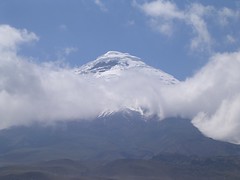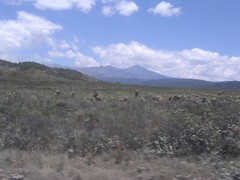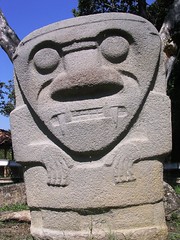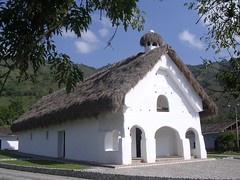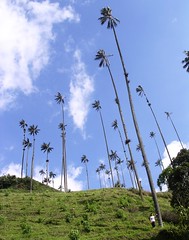Baños is a small city which rises in a flat piece of land, where the Andean valleys begin their tortuous descent towards the Amazon basin… we get there leaving the Pan-American highway near Ambato, city center of one of the most colored carnivals of Latin America (“fiestas de las flores y las frutas”). In the subtropical climate of Baños meet all the forces of nature: the Tungurahua volcano that dominate the village and it’s currently in eruption, frequent earthquakes, some impressive cascades and the clouds that incessantly thickens on the flanks of the mountains. In reason, the inhabitants of Baños talk with emphasis about the last eruption of the Tungurahua (August 2006), when part of the pueblo was destroyed. However, several Ecuadorian tourists come here, attracted by the hot springs of warm and sulfurous water; we also find a pleasant place, where we have a good time before the breathtaking descent towards the Amazon river basin.
Cotopaxi National Park
Exactly in front of the bridge which is the entrance gate to the city of Latacunga, a young boy tell us to go up on its rickety bus. It’s early in the morning, we begin the travel towards the covered by snow and perfectly conical top of the Cotopaxi volcano. The road rises inexorably: three, four, five thousand meters, the landscape becomes even more impressive. The silence owns these windy places, lived by the only animals have been able to adapt to the hard Andean climate (alpacas, condors, pumas, wild horses). For a moment we dream to go up till the top of the Cotopaxi crater to dominate an exterminated horizon, but climbing the highest active volcano of the world is not an adventure that could be organized in five minutes… some horses, pride of their freedom, follow us suspiciously while we walk around the Limpiopungo lagoon. Three big condors of the Andes caress the lost in clouds peak of the Rumiñahui volcano, where a warm and blinding sun (the god Inti in the Incaic culture, indeed) tries to open itself the way in the foggy cover.
On the way back we pass near Saquisili, a village which is center of one of the most colored Ecuadorian markets, every Thursday.
Maiz vs oil: Latin American mirages
During the last year, the high petrol price has stimulated the production of biofuels from alternative sources (biomass). For effect of the crescent corn demand (used to produce bio ethanol) on the part of the North-American market, the price of this cereal increases, breaking up any record. The main producers, United States, China, Argentine, Mexico, Brazil, and in general the whole Latin American region, go on consequently to increase the production and the extension of agricultural territory. In this scenery, the cultivation of transgenic maize becomes more than a temptation, rising a question: is it ethical to transfer the production of a basic element in the diet of millions of people towards the tanks of our cars? Ecuador represents an emblematic example of this contradiction: in the Amazonian river basin the extraction of oil and in the Western region the crescent maize production, while many people continue to face the challenge against starvation. As we don’t like to talk about problems that seem far from the possibilities of any single person, at least without giving a little hope, we flag some Ecuadorian associations that operate in the field of human rights, rural communities and ecology; maybe someone would be interested in activities of cooperation/volunteering in Equador: Ecuador volunteer, Jatun Sacha, and many others we didn’t contact directly (mainly aiming at supporting rights of the indigenous communities of the Amazonian rainforest).
In Quito
The Andean landscape becomes extremely variable in the northern part of Ecuador: from semi-desertic valleys to impressive green hills. After hours of roller coaster we reach Otavalo, a village where one of the most important Ecuadorian indigenous markets takes place. We continue towards Quito, the capital, a gem suspended between the snowed peaks of the Andean volcanoes. We are literally conquered by the socio-cultural ferment which enlivens the city, in a few days we know many people, artesanos and people of the street, we talk with NGOs about cooperation, voluntary work and with cultural foundations. We enter in contact with new friends who hopefully will help us to trace a good itinerary towards the eastern Amazon region. We accidentally discover the ethnographic museum managed by the organization Mindalae, an interesting mosaic of the Ecuadorian cultures. From the African influence of the north-western region to the indigenous groups of the forest (Shuar, Siona and Secoya, Achuar, Huaorani), skillful craftsmen of the nature, without forgetting the Andean culture (Quechua).
Towards Ecuador, goodbye Colombia
The deep canyons dig incurable wounds along the Andean ridge and mark the border between Colombia and Equador: we reach Ipiales following the Pan-American highway from Popayan through Pasto. We greet therefore Colombia, a large and wonderfully wild country, sad and crazy, happy and “thief”… Colombia, a country that more than every other Andean state, has been underestimating its most precious treasure, the wisdom of its indigenous peoples, asphyxiating their culture in a logic of useless conflict. Colombia, the country that condenses all its seducing fascination in the novel One Hundred Years of Solitude (Cien Años de Soledad), written by the Colombian genius, Gabriel Garcia Marquez.
“Bienvenidos al Ecuador” (Welcome to Equador), says the enormous cartel: the next challenge and many projects to realize, our dream to discover the Amazon. After traveling for so many months we reach the half of the world: a foot to north and the other one to south, or vice versa, we cut the line of the Equator.
San Agustin
From Tierradentro the unpaved road goes down to the the bottom of impressive valleys, towards the pueblo of La Plata. The heat increases, entering in the department of Huila: after Garzon and Pitalito, two dusty cities, we reach San Agustin, the “archaeological capital” of Colombia. Reputation due to the traces left by a mysterious Pre-Colombian civilization, clearly related with the cultures of Ecuador and Peru. The monolithic statues narrate the history of a people who underwent the cultural influence of the Andean world and the fascination of the gorgeous Amazonian nature, thanks to the strategic position of San Agustin. Here, the most diffused means of transporting is still the horse, while the typical Colombian chivas transport merchandise and campesinos in unbelievable number, during market days.
The return travel towards Popayan is a a hard trip in camioneta, crossing fields, paramo and forests, flanking tired volcanoes and swallowing kilos of powder… we dream a shower, but what a privilege to visit such remote places.
Tierradentro
The archaeological site of Tierradentro is an impressive and mysterious artwork, from an unknown but refined civilization. Located in the esplanades of Segovia, El Duende, El Tablòn, Alto de San Andres and El Aguacate, the hipogeos of Tierradentro are oval burial chambers, with a deepness that reaches nine meters. A winding staircase, built using volcanic stones, leads to the entrance, while two columns support the circular vault inside of each tomb. The walls are richly decorated with geometric and anthropomorphic figures, using red and black (life and death respectively), on white background. Nearly nothing was found in the chambers when they were discovered, because of the thieves activity (guaqueros), but what remains gives a clear idea of how incredible were these architecture artworks, able to resist the tremendous earthquakes that periodically hit the region of Tierradentro.
A friend, beyond that many beautiful photos, left trace of our nights in San Andres Pisimbalà, follow this link: www.flickr.com/photos/mariusencolombia.
Cauca valley, towards Tierradentro
In a day of movements with buses and camionetas we cover the whole Cauca valley, from Armenia (eje cafetero) to Popayan, passing through the lively city of Cali. Our goal is the region of Tierradentro, an archaeological site, almost unknown by tourists for problems of security, but particularly interesting for the presence of underground burial chambers, unique example of Pre-Columbian art (V-VII sec D.c.). The village of San Andres Pisimbalà is a charming place, inhabited by extremely nice people, belonging to the Paèz indigenous community. It remembers to us Chiapas and Guatemala, where we lived unforgettable experiences. To reach this pueblo an entire day of travel on unpaved roads is needed, but just for this reason the region conserves its authentic beauty. Here, the nature is wild and strong, leaving no satisfactions to the campesinos, nevertheless you can breathe an incredible peacefulness. We stay at Doña Marta’s casa familiar: she’s a nice old woman who loves cooking us the best arepas of Colombia.
Salento and Cocora Valley
Rising towards the peaks of the Nevado Ruiz, we discover the small village of Salento, a island of peacefulness in the middle of the wonderful Colombian coffee growing region (eje cafetero). A pueblo lost in the past and dominated by the rhythms of nature, that shows its most impressive side here. In direction of the Andean nevados in fact extends the “Valle de Cocora” (Cocora Valley), an Alpine-like valley, where the wax palms, a biological species heading towards extinction that catches up considerable heights (until 80 meters), grow numerous. Dipped in the mountain jungle, we find the ideal place to go for a walk, trek and horse-ride.
Armenia
Armenia is one of the most desolated cities we’ve visited during our travel: in the gray buildings and in the looks of the people, in wide measure of Slavic origin, hides a piece of Balkans. In the evening, the center gets full of street nomads, everyone with his “mistaken history” to tell. We get lost in Rosalba’s silences, a girl from Cali with three sons, two recently born and the last one still in her womb, the husband in jail and an ocean of loneliness to carry, heavy as a cross. She gives us all she can, a smile and two splendid bracelets, how to return this kindness?

